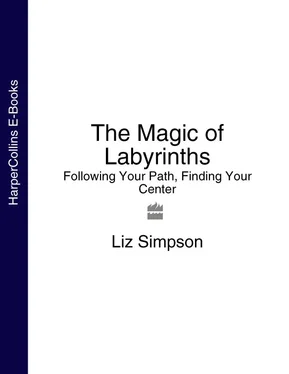The most common explanation for the proliferation of labyrinths across so many different cultures is that we are each responsive to subliminal perceptions. Jung argued that the collective unconscious is formed of two parts – instincts and archetypes, which are universally inherited and mutually dependant. While our instincts are biological – such as the flight, freeze or fight responses experienced when facing danger – the archetypes we each store in our unconscious memory are equally primordial but are higher, spiritually-charged functions.
The word “archetype” comes from the Greek arch meaning “origin” and tupos meaning “imprint.” These universally understood themes or emotional models become significant to different people at different times in their lives – particularly during the periods we call “rites of passage.” They are personified as characters we are all familiar with. Many of them feature prominently in fairy stories, such as the Wicked Stepmother, the Fairy Godmother, the Trickster, the Mentor, and the Shapeshifter. Certain key archetypes are specifically linked to the labyrinth as a symbol of our journey towards spiritual development. The most significant is the Hero – the role we take on when we pluck up the courage to embark on the quest to “find ourselves” and integrate all the fragmented pieces of the Self into one complete and balanced whole. (For more on this, see chapter 3.)
Then there is the Shadow archetype – the dark, suppressed, rejected energy which is depicted in stories as a monster, housed inside a dark cavern, which the Hero must confront and tame or vanquish in order to prevent his or her destruction. In our own lives, the Shadow represents all those parts of ourselves which we prefer not to acknowledge but most readily see and criticize in others. One of the most famous stories about a labyrinth is the myth of Theseus and the Minotaur where our hero enters the sinister maze-world of the beast in order to end the killing spree it engages in every nine years when fourteen young Athenian youths and maidens are sent to Crete as tribute to King Minos ( see here).
Archetypes and myths – the stories woven around such universal models of human psychological development – were, in Jung’s view, essential to our human need for self-understanding, as well as to help to mitigate our fear of personal isolation. Jung argued the concept of an inherited “Group Mind” or collective unconscious by demonstrating the similarity of mythologies across cultures, suggesting that these were the building blocks of religion.
Jung’s fascination with the primordial imprinting that leads us to seek a spiritual or religious explanation for the world around us, and our role within it, was expressed through his drawings. It is said that every morning he would sketch small circles as representations of his inner state that day. Jung noticed how these circles, such as the mandalas used as meditation tools by eastern mystics – as with labyrinths – brought everything to a single central point. The great psychoanalyst’s interpretation of this universal motif was that it symbolized the Self’s incessant journey towards higher meaning and purpose.
Likewise, the labyrinth is a universally imprinted archetype or theme illustrating our life’s journey towards spiritual development and completion. As you will discover later in this book, it can be used as both a personal tool and one that unites communities, thus fuelling our sense of Oneness with our environment.
One Mind, Many Applications?
There is a complementary view that also bears mentioning. One that may also explain the mysterious origins of the labyrinth and that similarly speaks to our psychological need to feel part of a whole. This alternative view helps to demonstrate that we are not so different from peoples who lived on this Earth 10, 20, 30 or even 40,000 years ago. Indeed, contemplating the enduring facets of human nature helps to reinforce the relevance of the labyrinth as an archetypal symbol that is as psychologically valuable to us today as it was way back when.
Much of our popular historical knowledge cloaks the fact that considerably more early crosscultural contact took place than was once thought. For example, most children are taught that Henry the Navigator or Christopher Columbus “discovered” America in the fifteenth century. Some may even have heard of Amerigo Vespucci or John Cabot (Giovanni Caboto) who, controversially, claimed to have preceded them. This completely disregards evidence that expeditions to the New World had been undertaken by peoples originally from Siberia (c. 70,000–9,000B.C.). Other suggested early explorers of the Americas, with varying degrees of evidence, range from Indonesians (c. 6,000–1,500B.C.), the Japanese (c. 5000B.C.) and Afro-Phoenicians (c. 1000B.C.–300A.D.).
Certainly, some archaeologists and historians now believe that the Vikings may have traveled down from Newfoundland to New England and even reached North Carolina. And it seems likely that these expeditions were not all one way, given the record of two Indians having been shipwrecked in Holland around 60B.C., causing considerable interest and excitement at the time. There are many other examples that provide a richer view of history than most of us were taught at school.
Given that there was considerable cross-cultural contact between peoples much earlier than we have been led to believe, this can be linked with contemporary evidence for the way ideas originating within one small group can spread like wildfire. Hence, we can see how a symbol such as the labyrinth could have come to enjoy such universal popularity from a single source.
Today we call it “viral marketing” or “buzz,” but basically it is old-fashioned word of mouth. In his book The Tipping Point, Malcolm Gladwell outlines three criteria or rules for the proliferation of social epidemics and he discusses how certain messages, behaviors, ideas, and their products spread like infectious diseases. The concept of a labyrinth, stemming from a single source, meets all three of these criteria.
First, you need a small number of people with both the creativity to understand the impact of a new idea and the personal magnetism or charisma with which to promote it. Such people in early times were called “shamans.” Shamanism, said to be the world’s oldest religion, spiritual discipline and medical approach, originated in Siberia – and it was here that a labyrinth carving was found, dating back over 7,000 years. The shaman worldview offers an experiential path to knowledge, gained through the process of ritual, meditation and a concept of trials or tests that is akin to the Hero’s journey through the labyrinth ( see chapter 3). Like the labyrinth, while variations exist between cultures, the concept of shamanism is very similar whether in the Americas, Africa, and Australasia or Lapland, Malaysia, and Peru.
The shaman’s role within a society was to straddle the world of reality and the world of spirit. As such they demonstrated that all-important psychological need which is now being explored more actively through environmental and spiritual groups – that of the interdependence and unity of nature and humankind. Interestingly, the shaman did not simply represent the Divine, as priests and other religious figures do. The shaman is Divine, in the way that we have been urged to think of ourselves by many prophets and philosophers, such as the fourteenth-century Christian mystic, Meister Eckhart, who said:
Here, in my own soul, the greatest of all miracles has taken place. God has returned to God.
In the same way that the simple act of walking or tracing a labyrinth can unite body and spirit, the shaman demonstrated the spiritual affinity between plant, person, and place.
Читать дальше












